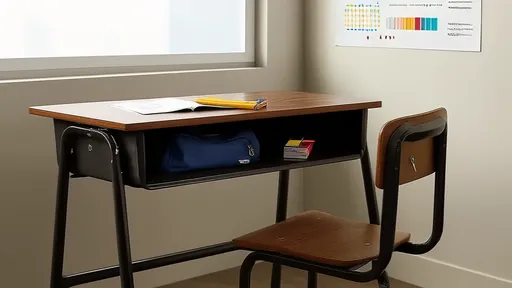The height of a student's desk might seem like a minor detail in the grand scheme of education, but its impact on learning, posture, and long-term health is anything but insignificant. For years, educators and ergonomic experts have emphasized the importance of properly sized furniture in classrooms, yet many schools still rely on one-size-fits-all solutions. The consequences of this oversight are far-reaching, affecting everything from concentration levels to physical development.
Why Desk Height Matters
A desk that is too high or too low forces the body into unnatural positions. When a student’s feet don’t rest flat on the floor or their arms strain to reach the writing surface, discomfort sets in quickly. This discomfort isn’t just a fleeting annoyance—it can lead to chronic issues like back pain, neck strain, and even repetitive stress injuries. More immediately, an ill-fitting desk distracts from learning. A child adjusting their posture every few minutes is a child not fully engaged in the lesson.
Research has shown that proper ergonomics in the classroom can improve both academic performance and overall well-being. A study published in the Journal of School Health found that students using adjustable desks demonstrated better focus and fewer complaints of physical discomfort. Yet, despite this evidence, the majority of classrooms still feature static, non-adjustable furniture. The assumption that children of the same age group are uniform in size is fundamentally flawed, given the natural variation in growth rates among students.
The Historical Oversight
The standardization of school furniture dates back to the industrial era, when efficiency often trumped individual needs. Factories mass-produced desks at fixed heights, and schools adopted them for convenience. Little thought was given to the long-term effects on students’ bodies. Even today, budget constraints and logistical challenges prevent many schools from upgrading to adjustable or properly sized options. The result is a system where children are expected to adapt to their environment rather than the other way around.
Some countries have begun to address this issue. In Scandinavia, for example, adjustable desks and chairs are commonplace, reflecting a broader cultural emphasis on ergonomics and child-centered design. Meanwhile, in many other parts of the world, the conversation around classroom furniture remains stagnant. Parents and educators often prioritize textbooks, technology, and extracurricular programs over what might seem like a mundane piece of furniture—until problems arise.
The Physical and Cognitive Connection
The relationship between posture and cognitive function is well-documented. Slouching or sitting in an awkward position can reduce blood flow and oxygen to the brain, impairing concentration and memory retention. Conversely, a well-supported spine promotes alertness and engagement. When a desk is the correct height, writing becomes more fluid, and fine motor skills develop more naturally. For younger children, this is particularly critical, as improper desk height can hinder the development of proper pencil grip and handwriting techniques.
Beyond academics, the long-term health implications cannot be ignored. Poor posture during formative years can lead to spinal misalignments and musculoskeletal disorders later in life. Chiropractors and physical therapists increasingly report seeing younger patients with issues stemming from prolonged sitting in poorly designed school furniture. The irony is that these problems are entirely preventable with simple, cost-effective solutions.
Moving Toward Solutions
Change doesn’t necessarily require a complete overhaul of classroom furniture. Simple adjustments, like footrests for shorter students or raised platforms for desks that are too low, can make a significant difference. Some schools have experimented with standing desks or flexible seating arrangements, allowing students to choose workspaces that suit their bodies. While these options may not be feasible everywhere, they highlight the growing recognition of ergonomics in education.
Advocacy is another crucial piece of the puzzle. Parents, teachers, and health professionals must push for policies that prioritize ergonomic standards in schools. This includes lobbying for funding to replace outdated furniture and educating administrators about the tangible benefits of proper desk height. When stakeholders understand that this isn’t just about comfort—but about academic success and long-term health—the conversation shifts from whether to invest to how quickly changes can be implemented.
The Bigger Picture
In an era where education systems are scrutinized for their ability to prepare students for the future, something as basic as desk height might seem trivial. But it’s precisely these overlooked details that shape daily experiences and outcomes. A classroom should be a space where every child can thrive physically and mentally, and that starts with the furniture they use for hours each day.
The push for ergonomic school furniture is part of a broader movement toward student-centered learning environments. When we design classrooms with the human body in mind, we send a message that students’ well-being matters. It’s a small change with the potential for profound impact—one properly sized desk at a time.

By /Aug 7, 2025

By /Aug 6, 2025

By /Aug 6, 2025

By /Aug 6, 2025

By /Aug 6, 2025

By /Aug 6, 2025

By /Aug 6, 2025

By /Aug 6, 2025

By /Aug 6, 2025

By /Aug 6, 2025

By /Aug 6, 2025

By /Aug 6, 2025

By /Aug 6, 2025

By /Aug 6, 2025

By /Aug 6, 2025

By /Aug 6, 2025

By /Aug 6, 2025

By /Aug 6, 2025

By /Aug 6, 2025

By /Aug 6, 2025